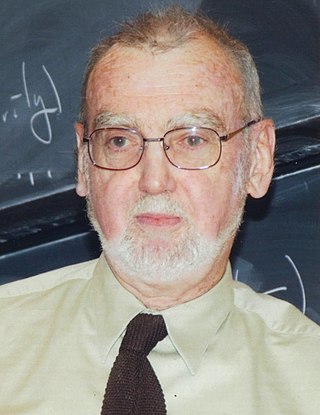
Robert Phelan Langlands, is a Canadian mathematician. He is best known as the founder of the Langlands program, a vast web of conjectures and results connecting representation theory and automorphic forms to the study of Galois groups in number theory, for which he received the 2018 Abel Prize. He was an emeritus professor and occupied Albert Einstein's office at the Institute for Advanced Study in Princeton, until 2020 when he retired.
In representation theory and algebraic number theory, the Langlands program is a web of far-reaching and consequential conjectures about connections between number theory and geometry. Proposed by Robert Langlands, it seeks to relate Galois groups in algebraic number theory to automorphic forms and representation theory of algebraic groups over local fields and adeles. Widely seen as the single biggest project in modern mathematical research, the Langlands program has been described by Edward Frenkel as "a kind of grand unified theory of mathematics."

In mathematics, E8 is any of several closely related exceptional simple Lie groups, linear algebraic groups or Lie algebras of dimension 248; the same notation is used for the corresponding root lattice, which has rank 8. The designation E8 comes from the Cartan–Killing classification of the complex simple Lie algebras, which fall into four infinite series labeled An, Bn, Cn, Dn, and five exceptional cases labeled G2, F4, E6, E7, and E8. The E8 algebra is the largest and most complicated of these exceptional cases.

Bertram Kostant was an American mathematician who worked in representation theory, differential geometry, and mathematical physics.
In mathematics, the orbit method establishes a correspondence between irreducible unitary representations of a Lie group and its coadjoint orbits: orbits of the action of the group on the dual space of its Lie algebra. The theory was introduced by Kirillov for nilpotent groups and later extended by Bertram Kostant, Louis Auslander, Lajos Pukánszky and others to the case of solvable groups. Roger Howe found a version of the orbit method that applies to p-adic Lie groups. David Vogan proposed that the orbit method should serve as a unifying principle in the description of the unitary duals of real reductive Lie groups.
In mathematics, the local Langlands conjectures, introduced by Robert Langlands, are part of the Langlands program. They describe a correspondence between the complex representations of a reductive algebraic group G over a local field F, and representations of the Langlands group of F into the L-group of G. This correspondence is not a bijection in general. The conjectures can be thought of as a generalization of local class field theory from abelian Galois groups to non-abelian Galois groups.
The Atlas of Lie Groups and Representations is a mathematical project to solve the problem of the unitary dual for real reductive Lie groups.
David Alexander Vogan, Jr. is a mathematician at the Massachusetts Institute of Technology who works on unitary representations of simple Lie groups.
In mathematics, a Zuckerman functor is used to construct representations of real reductive Lie groups from representations of Levi subgroups. They were introduced by Gregg Zuckerman (1978). The Bernstein functor is closely related.
In mathematics, the Langlands classification is a description of the irreducible representations of a reductive Lie group G, suggested by Robert Langlands (1973). There are two slightly different versions of the Langlands classification. One of these describes the irreducible admissible (g,K)-modules, for g a Lie algebra of a reductive Lie group G, with maximal compact subgroup K, in terms of tempered representations of smaller groups. The tempered representations were in turn classified by Anthony Knapp and Gregg Zuckerman. The other version of the Langlands classification divides the irreducible representations into L-packets, and classifies the L-packets in terms of certain homomorphisms of the Weil group of R or C into the Langlands dual group.
Anthony W. Knapp is an American mathematician at the State University of New York, Stony Brook working on representation theory, who classified the tempered representations of a semisimple Lie group.
Fokko du Cloux was a Dutch mathematician and computer scientist. He worked on the Atlas of Lie groups and representations until his death.
In mathematics, the Arthur conjectures are some conjectures about automorphic representations of reductive groups over the adeles and unitary representations of reductive groups over local fields made by James Arthur (1989), motivated by the Arthur–Selberg trace formula.
Diana Frost Shelstad is a mathematician known for her work in automorphic forms. She is a professor at Rutgers University–Newark. She earned her doctorate at Yale University in 1974 studying real reductive algebraic groups.
In mathematics, a unipotent representation of a reductive group is a representation that has some similarities with unipotent conjugacy classes of groups.
In the field of mathematics known as representation theory, an L-packet is a collection of irreducible representations of a reductive group over a local field, that are L-indistinguishable, meaning they have the same Langlands parameter, and so have the same L-function and ε-factors. L-packets were introduced by Robert Langlands in, .

Veeravalli Seshadri Varadarajan was an Indian mathematician at the University of California, Los Angeles, who worked in many areas of mathematics, including probability, Lie groups and their representations, quantum mechanics, differential equations, and supersymmetry.
Nolan Russell Wallach is a mathematician known for work in the representation theory of reductive algebraic groups. He is the author of the 2-volume treatise Real Reductive Groups.

Kari Kaleva Vilonen is a Finnish mathematician, specializing in geometric representation theory. He is currently a professor at the University of Melbourne.
Peter Engel Trapa is an American mathematician and the dean of the College of Science at the University of Utah. His research focus is on the representation theory of reductive Lie groups. Trapa received his Bachelor of Arts in mathematics and integrated science from Northwestern University and his Ph.D. in mathematics from the Massachusetts Institute of Technology. While at MIT, Trapa studied representation theory with David Vogan. He completed postdoctoral work at the Institute for Advanced Study in Princeton, NJ, and Harvard University.





